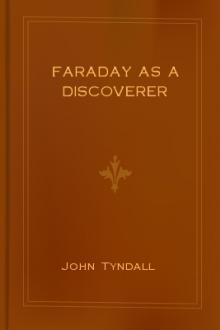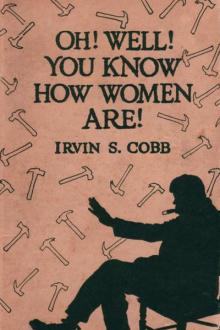The Chemical History of a Candle by Michael Faraday (detective books to read TXT) 📕

- Author: Michael Faraday
- Performer: -
Book online «The Chemical History of a Candle by Michael Faraday (detective books to read TXT) 📕». Author Michael Faraday
In the mean time look at the change which has taken place in the water to which we have applied heat—it is losing its fluid state. You may tell this by two or three circumstances. I have covered the mouth of this glass flask, in which water is boiling, with a watch-glass. Do you see what happens? It rattles away like a valve chattering, because the steam rising from the boiling water sends the valve up and down, and forces itself out, and so makes it clatter. You can very easily perceive that the flask is quite full of steam, or else it would not force its way out. You see, also, that the flask contains a substance very much larger than the water, for it fills the whole of the flask over and over again, and there it is blowing away into the air; and yet you cannot observe any great diminution in the bulk of the water, which shews you that its change of bulk is very great when it becomes steam.
I have put our iron bottles containing water into this freezing mixture, that you may see what happens. No communication will take place, you observe, between the water in the bottles and the ice in the outer vessel. But there will be a conveyance of heat from the one to the other; and if we are successful—we are making our experiment in very great haste—I expect you will by-and-by, so soon as the cold has taken possession of the bottles and their contents, hear a pop on the occasion of the bursting of the one bottle or the other; and, when we come to examine the bottles, we shall find their contents masses of ice, partly enclosed by the covering of iron which is too small for them, because the ice is larger in bulk than the water. You know very well that ice floats upon water: if a boy falls through a hole into the water, he tries to get on the ice again to float him up. Why does the ice float?—think of that, and philosophise. Because the ice is larger than the quantity of water which can produce it; and therefore the ice weighs the lighter, and the water is the heavier.
To return now to the action of heat on water. See what a stream of vapour is issuing from this tin vessel! You observe, we must have made it quite full of steam to have it sent out in that great quantity. And now, as we can convert the water into steam by heat, we convert it back into liquid water by the application of cold. And if we take a glass, or any other cold thing, and hold it over this steam, see how soon it gets damp with water; it will condense it until the glass is warm—it condenses the water which is now running down the sides of it. I have here another experiment to shew the condensation of water from a vaporous state back into a liquid state, in the same way as the vapour, one of the products of the candle, was condensed against the bottom of the dish, and obtained in the form of water; and to shew you how truly and thoroughly these changes take place, I will take this tin flask, which is now full of steam, and close the top. We shall see what takes place when we cause this water or steam to return back to the fluid state by pouring some cold water on the outside. [The Lecturer poured the cold water over the vessel, when it immediately collapsed.] You see what has happened. If I had closed the stopper, and still kept the heat applied to it, it would have burst the vessel; yet, when the steam returns to the state of water, the vessel collapses, there being a vacuum produced inside by the condensation of the steam. I shew you these experiments for the purpose of pointing out that in all these occurrences there is nothing that changes the water into any other thing—it still remains water; and so the vessel is obliged to give way, and is crushed inwards, as in the other case, by the further application of heat, it would have been blown outwards.
[Illustration: Fig. 12.]
And what do you think the bulk of that water is when it assumes the vaporous condition? You see that cube [pointing to a cubic foot]. There, by its side, is a cubic inch, exactly the same shape as the cubic foot, and that bulk of water [the cubic inch] is sufficient to expand into that bulk [the cubic foot] of steam; and, on the contrary, the application of cold will contract that large quantity of steam into this small quantity of water.
[Illustration: Fig. 13.]
[One of the iron bottles burst at that moment.] Ah! There is one of our bottles burst, and here you see is a crack down one side an eighth of an inch in width. [The other now exploded, sending the freezing mixture in all directions.] This other bottle is also broken; although the iron was nearly half-an-inch thick, the ice has burst it asunder. These changes always take place in water: they do not require to be always produced by artificial means,—we only use them here because we want to produce a small winter round that little bottle, instead of a long and severe one. But if you go to Canada, or to the North, you will find the temperature there out of doors will do the same thing as has been done here by the freezing mixture.
To return to our quiet philosophy. We shall not in future be deceived, therefore, by any changes that are produced in water. Water is the same everywhere, whether produced from the ocean or from the flame of the candle. Where, then, is this water which we get from a candle? I must anticipate a little, and tell you. It evidently comes, as to part of it, from the candle; but is it within the candle beforehand? No. It is not in the candle; and it is not in the air round about the candle which is necessary for its combustion. It is neither in one nor the other, but it comes from their conjoint action, a part from the candle, a part from the air; and this we have now to trace, so that we may understand thoroughly what is the chemical history of a candle when we have it burning on our table. How shall we get at this? I myself know plenty of ways, but I want you to get at it from the association in your own minds of what I have already told you.
I think you can see a little in this way. We had just now the case of a substance which acted upon the water in the way that Sir Humphrey Davy shewed us[13], and which I am now going to recall to your minds by making again an experiment upon that dish. It is a thing which we have to handle very carefully, for you see, if I allow a little splash of water to come upon this mass, it sets fire to part of it; and if there were free access of air, it would quickly set fire to the whole. Now, this is a metal—a beautiful and bright metal—which rapidly changes in the air, and, as you know, rapidly changes in water. I will put a piece on the water, and you see it burns beautifully, making a floating lamp, using the water in the place of air. Again, if we take a few iron filings or turnings, and put them in water, we find that they likewise undergo an alteration. They do not change so much as this potassium does, but they change somewhat in the same way; they become rusty, and shew an action upon the water, though in a different degree of intensity to what this beautiful metal does: but they act upon the water in the same manner generally as this potassium. I want you to put these different facts together in your minds. I have another metal here [zinc], and when we examined it with regard to the solid substance produced by its combustion, we had an opportunity of seeing that it burned; and I suppose, if I take a little strip of this zinc and put it over the candle, you will see something half-way, as it were, between the combustion of potassium on the water and the action of iron,—you see there is a sort of combustion. It has burned, leaving a white ash or residuum, and here also we find that the metal has a certain amount of action upon water.
By degrees we have learned how to modify the action of these different substances, and to make them tell us what we want to know. And now, first of all, I take iron. It is a common thing in all chemical reactions, where we get any result of this kind, to find that it is increased by the action of heat; and if we want to examine minutely and carefully the action of bodies one upon another, we often have to refer to the action of heat. You are aware, I believe, that iron-filings burn beautifully in the air; but I am about to shew you an experiment of this kind, because it will impress upon you what I am going to say about iron in its action on water. If I take a flame and make it hollow;—you know why, because I want to get air to it and into it, and therefore I make it hollow—and then take a few iron-filings and drop them into the flame, you see how well they burn. That combustion results from the chemical action which is going on when we ignite those particles. And so we proceed to consider these different effects, and ascertain what iron will do when it meets with water. It will tell us the story so beautifully, so gradually and regularly, that I think it will please you very much.
I have here a furnace with a pipe going through it like an iron gun-barrel, and I have stuffed that barrel full of bright iron-turnings, and placed it across the fire, to be made red-hot. We can either send air through the barrel to come in contact with the iron, or we can send steam from this little boiler at the end of the barrel. Here is a stop-cock which shuts off the steam from the barrel until we wish to admit it. There is some water in these glass jars, which I have coloured blue, so that you may see what happens. Now, you know very well that any steam I might send through that barrel, if it went through into the water, would be condensed; for you have seen that steam cannot retain its gaseous form if it be cooled down.
[Illustration: Fig. 14.]
You saw it here [pointing to the tin flask] crushing itself into a small bulk, and causing the flask holding it to collapse; so that if I were to send steam through that barrel, it would be condensed—supposing the barrel were cold: it is, therefore, heated to perform the experiment I am now about to shew you. I am going to send the steam through the barrel in small quantities; and you shall judge for yourselves, when you see it issue from the other end, whether it still remains steam. Steam is condensible into water, and when you lower the temperature of steam, you convert it back into fluid water; but I have lowered the temperature of the gas which I have collected in this jar, by passing it through water after it has traversed the iron barrel, and still it does not change back into water. I will take another test and apply to this gas. (I hold the jar in an inverted position, or my substance would escape.) If I now apply a light to the mouth of the jar, it ignites with a slight noise. That tells you that it is not steam. Steam puts out a fire—it does not burn; but you saw that what I had in that jar burnt. We may obtain this substance equally from water produced from the candle-flame as from any other source. When it is obtained by the action of the iron upon the aqueous vapour, it leaves the iron in a state very similar to that





Comments (0)